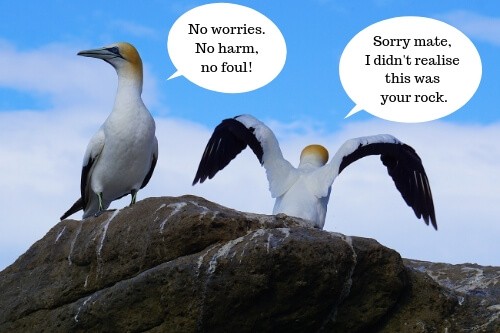
YouTube / iTunes / Spotify / Radio Public / Pocket Casts / Google Podcasts / Breaker / Overcast
Listen to ArtisanEnglish.jp posts & lesson intros here.
Phrase: No harm, no foul
To begin with, I chose today’s picture for no harm, no foul as a play on words.
Did you get a little chuckle out of it, or did it at least make you smile?
Foul – fowl, a bird is a fowl – It’s a play on words.
No matter; let’s give it some time to sink in.
The hardest thing to understand in another language is a joke.
I hope my joke hasn’t fallen on deaf ears or eyes in this case.
Anyways, we use no harm, no foul when someone has made a mistake that didn’t cause much trouble or inconvenience.
In basketball, when a player does something wrong or commits a foul, the other team gets a foul shot.
The foul shot is a penalty for committing a foul.
In life, when someone does something wrong, but no harm comes from it, we say no harm, no foul.
You can use this whenever people make a mistake or do something to you by accident that doesn’t have a harmful result.
Japanese roads are narrow.
Sometimes car mirrors will bump into each other.
It’s a good thing they are designed to turn in.
When they knock each other, at least one will usually turn in, preventing damage.
If this happens to you, you and the other driver can say no harm, no foul and then go on your way.
If you break someone’s mirror or they break yours, that’s a different story altogether.
In today’s picture, we can see that both birds are pretty friendly and easygoing.
One guy has a rock, and the other bird accidentally landed on it.
I suppose they don’t like to share, so once the other guy realized his mistake, he immediately apologized and left.
The bird, whose rock it was, didn’t get upset or violent.
He just said no harm, no foul (even though they are both birds) as the other went on his merry way.
Flesch-Kincaid Readability Test
This post is understandable by someone with at least a 6th-grade education (age 11).
On the Flesch-Kincaid reading-ease test, this post scores 82.
The easier a passage is to read, the higher the score on a scale of 0 – 100.

